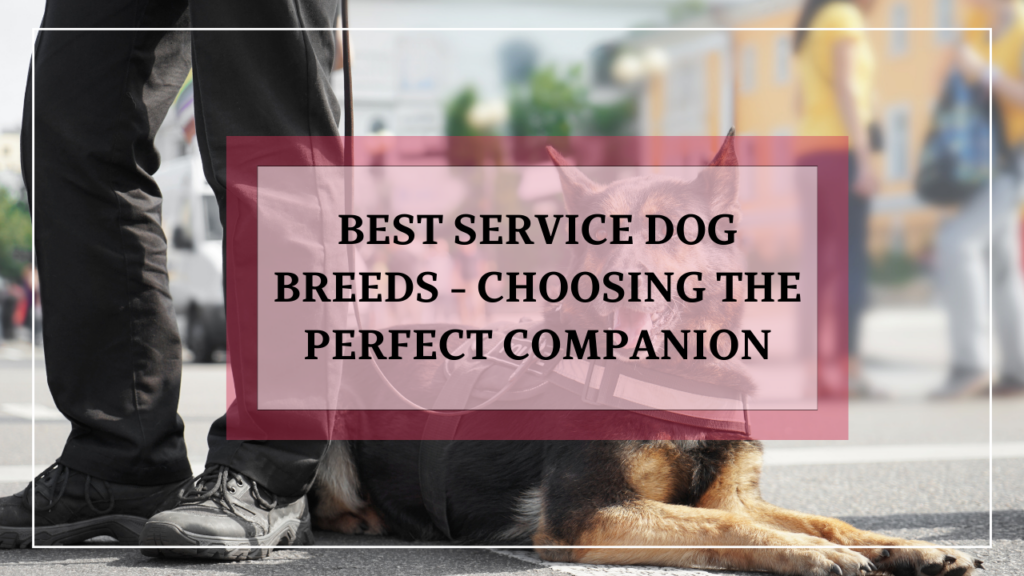Service dogs are more than just pets; they are lifelines for people with disabilities, providing essential support that enhances independence and quality of life. From guiding the visually impaired to alerting individuals of impending medical issues, service dogs perform tasks that are vital for their handlers’ well-being. Selecting the best service dog breed is a crucial decision, as not all dogs are suited for the demanding roles that service dogs must undertake.
In this comprehensive guide, we’ll explore the best service dog breeds, examining their traits, roles, and training requirements. Whether you’re looking for a guide dog, a mobility assistance dog, or a medical alert dog, this guide will help you find the perfect companion to meet your needs. Additionally, we’ll cover general information about service dogs, such as the qualities that make a good service dog, the different roles they can fulfill, and the legal considerations associated with owning a service dog.
What Makes a Good Service Dog?
The ideal service dog possesses a unique combination of traits that allow them to perform their tasks reliably and safely. Here are some of the key characteristics to look for when choosing a service dog:
- Intelligence: Service dogs must be highly trainable and capable of learning complex tasks.
- Temperament: A calm, steady temperament is essential. Service dogs must remain composed in various environments and situations.
- Loyalty and Bonding: A strong bond with their handler is critical, as service dogs often need to anticipate their handler’s needs.
- Health and Longevity: Service dogs require good health and a longer lifespan to ensure they can provide support for many years.
It’s important to distinguish between service dogs, emotional support animals (ESAs), and therapy dogs. While service dogs are trained to perform specific tasks to assist individuals with disabilities, ESAs provide comfort through their presence and do not require special training. Therapy dogs offer emotional support in settings like hospitals and schools but are not trained to assist with specific disabilities.
Factors to Consider When Choosing a Service Dog Breed
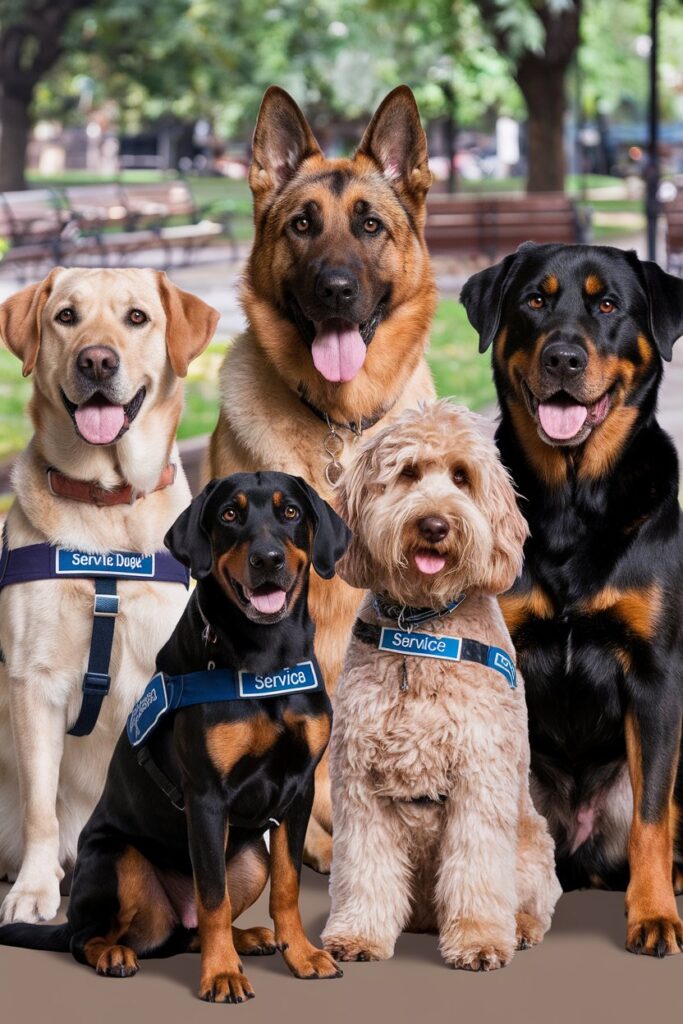
Selecting the best service dog breed involves more than just choosing a popular breed. It’s essential to consider various factors that align with the specific needs of the individual and the tasks the service dog will perform. Here are the key factors to keep in mind when choosing the right breed:
1. Size and Physical Capabilities
The size and physical abilities of a service dog should match the tasks it will be required to perform. For example:
- Large Breeds: Dogs like Great Danes or Bernese Mountain Dogs are well-suited for mobility assistance, as their size and strength allow them to help with physical tasks, such as supporting their handler’s weight or pulling a wheelchair.
- Medium Breeds: Dogs like Labrador Retrievers or Golden Retrievers are ideal for guide dog roles or retrieving objects because they are strong enough to assist but still manageable in size.
- Small Breeds: Dogs like Poodles or Cavalier King Charles Spaniels are better suited for tasks like medical alert or emotional support, where agility and a smaller size are advantageous.
2. Temperament and Behavior
A service dog must have a calm, stable temperament to perform its duties effectively. The ideal service dog should:
- Be Calm and Patient: Service dogs must remain composed in various environments, from busy public spaces to quiet homes. Breeds known for their calmness, such as Golden Retrievers and Poodles, are often preferred.
- Be Friendly and Non-Aggressive: Aggression or excessive shyness can be problematic for a service dog. Breeds with friendly, approachable natures, like Labrador Retrievers and Boxers, excel in service roles.
- Adaptability: Service dogs should adjust well to different environments and situations. They must be able to handle unpredictable events without becoming stressed or anxious.
3. Health and Longevity
Choosing a breed with good health and a long lifespan is essential for ensuring the service dog can provide support for many years. Consider the following:
- Genetic Health Issues: Some breeds are prone to specific genetic conditions that could shorten their working life. For example, German Shepherds and Boxers are known to have issues with hip dysplasia and heart problems, respectively. Regular vet check-ups and proper care can mitigate these risks.
- Lifespan: A longer lifespan means a longer working period. Breeds like Labrador Retrievers and Poodles tend to have longer lifespans compared to larger breeds like Great Danes.
4. Trainability
The ease with which a breed can be trained is a significant consideration. Highly trainable breeds are more likely to excel as service dogs because they can learn and perform complex tasks reliably. Key points to consider include:
- Intelligence: Breeds like Border Collies and Poodles are known for their intelligence and quick learning abilities, making them excellent candidates for service dog roles that require complex tasks.
- Willingness to Please: Breeds that are eager to please their handlers, such as Golden Retrievers and Labrador Retrievers, tend to be more motivated during training.
- Consistency in Training: Some breeds require consistent and ongoing training to maintain their skills. German Shepherds, for example, thrive with structured training and clear guidance.
5. Suitability for Specific Tasks
Different breeds are better suited to specific service dog roles based on their natural abilities and instincts. Consider the following:
- Guide Dogs: Breeds like Labrador Retrievers and Golden Retrievers are excellent for guiding individuals with visual impairments due to their size, temperament, and trainability.
- Mobility Assistance Dogs: Larger breeds like Bernese Mountain Dogs and Great Danes are ideal for providing physical support and stability.
- Medical Alert Dogs: Breeds with keen senses and strong bonds with their handlers, like Poodles and Collies, excel in medical alert roles, such as detecting seizures or low blood sugar.
- Emotional Support and Therapy Dogs: Smaller, affectionate breeds like Cavalier King Charles Spaniels are well-suited for providing emotional support and comfort to individuals with psychiatric conditions.
6. Lifestyle Compatibility
The service dog’s compatibility with your lifestyle is also crucial. Consider how the breed’s exercise needs, grooming requirements, and general care fit with your daily routine:
- Exercise Needs: Breeds like Border Collies and German Shepherds require a lot of physical and mental stimulation. If you lead an active lifestyle, these breeds may be a good fit. If you prefer a more sedentary lifestyle, a breed with lower exercise requirements, like a Cavalier King Charles Spaniel, might be better.
- Grooming: Some breeds, such as Poodles and Golden Retrievers, require regular grooming. If you prefer a low-maintenance dog, consider breeds with shorter coats and lower grooming needs.
- Living Environment: Consider whether the breed is suitable for your living situation. For example, larger breeds may need more space and may not be suitable for apartment living.
7. Bonding and Relationship
A strong bond between the service dog and handler is essential for the dog to anticipate needs and perform tasks effectively. Breeds known for their loyalty and attachment to their handlers, like Boxers and Labrador Retrievers, are often preferred.
Top 10 Best Service Dog Breeds
1. Labrador Retriever

Labrador Retrievers are widely regarded as one of the best service dog breeds. Known for their intelligence, patience, and friendly nature, they excel in various service roles, including guide dogs for the visually impaired and mobility assistance dogs. Labs are highly trainable and have a strong desire to please their handlers.
- Pros: Friendly, loyal, easy to train
- Cons: Prone to obesity, requires regular exercise
Case Study: A Labrador Retriever named Endal became famous for his work as a service dog, performing over 100 tasks for his disabled handler, including using an ATM and retrieving items from shelves. His incredible abilities earned him numerous awards and recognition worldwide.
2. Golden Retriever

Golden Retrievers are another popular choice for service dogs. They share many of the same traits as Labradors, such as intelligence and a gentle temperament. Golden Retrievers are often used as guide dogs, therapy dogs, and in medical alert roles due to their keen senses and ability to bond deeply with their handlers.
- Pros: Gentle, intelligent, adaptable to different roles
- Cons: Requires regular grooming, can be prone to hip dysplasia
Fun Fact: Golden Retrievers are known for their “soft mouths,” a trait that allows them to carry delicate items without damaging them, making them ideal for tasks like retrieving medication.
3. German Shepherd

German Shepherds are well-known for their work in police and military roles, but they also make excellent service dogs. Their intelligence, loyalty, and strong work ethic make them suitable for various tasks, including guide dogs, mobility assistance, and even psychiatric service dogs.
- Pros: Highly intelligent, loyal, protective
- Cons: Requires consistent training and exercise, can be prone to anxiety without proper socialization
Health Consideration: German Shepherds are prone to hip dysplasia, so regular vet check-ups and proper care are essential to ensure their longevity as service dogs.
4. Poodle
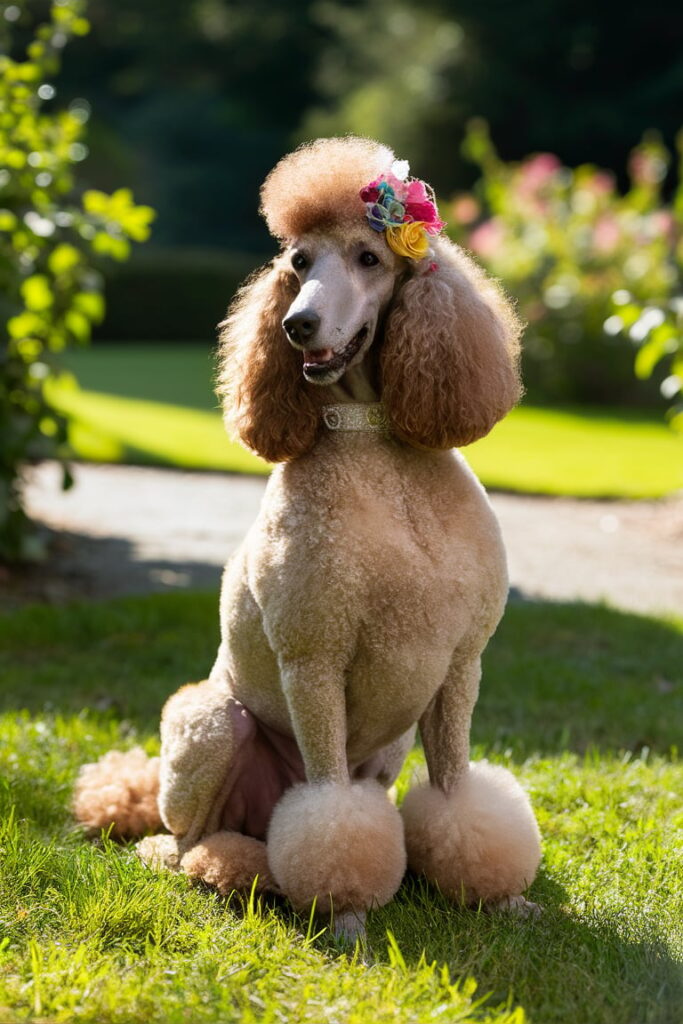
Poodles are often underestimated as service dogs, but their intelligence and hypoallergenic coats make them an excellent choice for individuals with allergies. Poodles are highly trainable and can perform various tasks, from medical alerts to mobility assistance.
- Pros: Hypoallergenic, intelligent, versatile in training
- Cons: Requires regular grooming, can be sensitive to harsh training methods
Training Tip: Poodles respond best to positive reinforcement and gentle training techniques. Harsh methods can make them anxious, so a patient approach is key.
5. Bernese Mountain Dog

Bernese Mountain Dogs are large, strong, and gentle, making them ideal for mobility assistance and other physical support tasks. They are known for their calm demeanor and loyalty, which makes them reliable companions for individuals with disabilities.
- Pros: Strong, gentle, excellent for mobility assistance
- Cons: Shorter lifespan, prone to certain health issues like hip dysplasia and cancer
Fact: Despite their size, Bernese Mountain Dogs are incredibly gentle and are often referred to as “gentle giants.” They are particularly good with children and other pets.
6. Border Collie

Border Collies are one of the most intelligent dog breeds, known for their quick learning abilities and problem-solving skills. They excel in tasks that require mental stimulation, making them ideal for medical alert and psychiatric service roles.
- Pros: Extremely intelligent, quick learner, excellent work ethic
- Cons: Requires a lot of mental and physical exercise, can be too energetic for some handlers
Exercise Needs: Border Collies require a significant amount of physical and mental stimulation. They thrive in environments where they have tasks to complete or puzzles to solve.
7. Boxer

Boxers are strong, loyal, and affectionate, making them excellent service dogs for emotional support and mobility assistance. They are particularly known for their ability to bond closely with their handlers, providing both physical and emotional support.
- Pros: Loyal, strong, good with children
- Cons: Prone to health issues like heart problems and cancer, requires regular exercise
Health Tip: Boxers are prone to heart conditions, so regular vet check-ups and a healthy diet are crucial to maintaining their health and longevity as service dogs.
8. Great Dane

Great Danes are one of the largest dog breeds, making them ideal for mobility assistance and physical support tasks. Their gentle nature and calm temperament make them well-suited for individuals who need a reliable and strong service dog.
- Pros: Strong, calm, excellent for mobility assistance
- Cons: Shorter lifespan, prone to certain health issues like hip dysplasia and bloat
Size Consideration: Due to their size, Great Danes require a home with ample space and may not be suitable for apartment living.
9. Cavalier King Charles Spaniel

Cavalier King Charles Spaniels are small but mighty when it comes to emotional support and therapy roles. Their affectionate and gentle nature makes them ideal for individuals with psychiatric conditions or those who need a comforting presence.
- Pros: Affectionate, easy to train, good for emotional support
- Cons: Requires regular grooming, can be prone to heart issues
Quote: “Cavalier King Charles Spaniels are often referred to as the ‘comforters’ of the dog world, offering unconditional love and support to their handlers.”
10. Collie

Collies are known for their alertness and trainability, making them excellent service dogs for detecting medical issues such as seizures or low blood sugar. They are also highly loyal and protective, making them a reliable choice for individuals who need a watchful companion.
- Pros: Alert, intelligent, good for medical alert roles
- Cons: Requires regular grooming, can be sensitive to harsh training methods
Training Insight: Collies excel in environments where they have a clear job to do. They are highly motivated by tasks and thrive when they are given responsibilities.
Types of Service Dogs and Their Roles
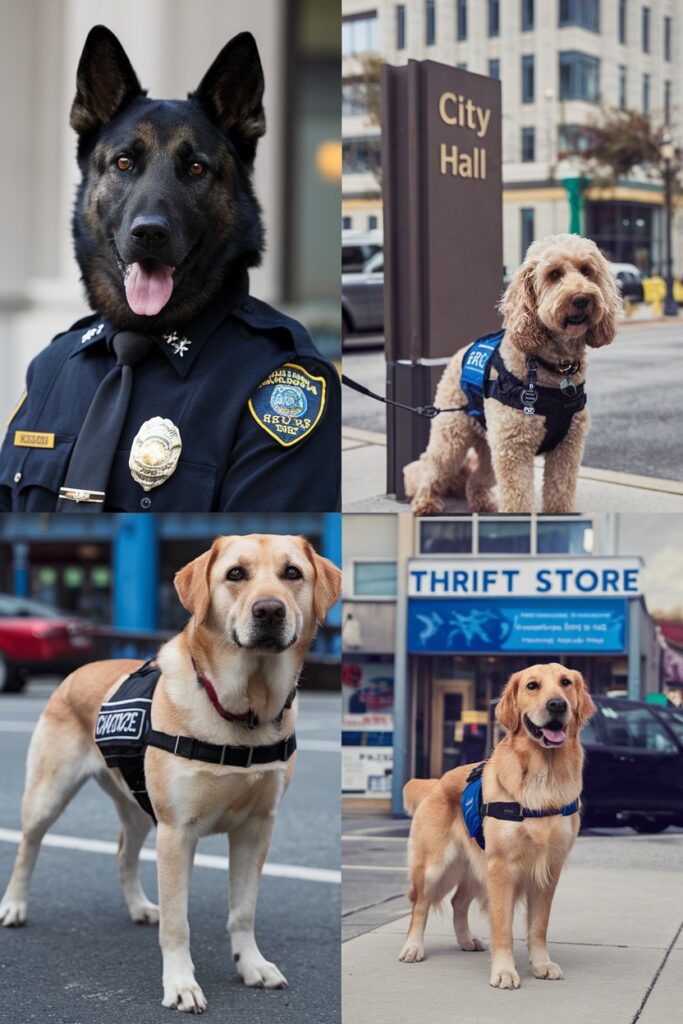
Service dogs are trained to perform a wide range of tasks that cater to different disabilities. Depending on the needs of the individual, certain breeds may be more suitable for specific roles. Below, we explore the main types of service dogs and discuss which breeds are best suited for each role.
Guide Dogs for the Visually Impaired
Guide dogs assist people who are blind or visually impaired by helping them navigate their environment safely. These dogs are trained to lead their handlers around obstacles, stop at curbs, and avoid dangerous situations like traffic. Guide dogs must have excellent focus, calm temperaments, and the ability to make independent decisions in challenging situations.
- Best Breeds: Labrador Retriever, Golden Retriever, German Shepherd
- Key Traits: Focus, intelligence, calmness under pressure
Fact: Guide dogs undergo rigorous training, often lasting 18 months or more, to ensure they can navigate various environments and protect their handlers from potential hazards.
Quote: “A guide dog is more than a set of eyes; it’s a constant companion and guardian, providing safety and independence to those with visual impairments.”
Mobility Assistance Dogs
Mobility assistance dogs provide support to individuals with physical disabilities, helping them with tasks such as retrieving objects, opening doors, and providing balance and stability. These dogs are often large and strong, capable of bearing weight and assisting with movement.
- Best Breeds: Bernese Mountain Dog, Great Dane, Labrador Retriever
- Key Traits: Strength, loyalty, patience
Case Study: A Great Dane named George helped his handler, who had multiple sclerosis, by providing balance and retrieving dropped items. His size and strength allowed his handler to regain some independence, making daily tasks more manageable.
Table: Comparison of Mobility Assistance Dog Breeds
| Breed | Strength | Calmness | Trainability | Lifespan |
| Bernese Mountain Dog | High | High | Medium | 7-10 years |
| Great Dane | Very High | High | Medium | 7-10 years |
| Labrador Retriever | Medium | High | High | 10-12 years |
Medical Alert Dogs
Medical alert dogs are trained to detect specific medical conditions, such as low blood sugar in diabetics, seizures in individuals with epilepsy, and even certain types of cancer. These dogs rely on their keen sense of smell and observation to alert their handlers before a medical event occurs, allowing them to take preventive measures.
- Best Breeds: Poodle, Collie, Labrador Retriever
- Key Traits: Sensitivity, alertness, strong sense of smell
Fun Fact: Some medical alert dogs can detect changes in blood sugar levels up to 30 minutes before a person experiences symptoms, giving them time to take necessary actions.
Health Consideration: Because medical alert dogs need to be constantly vigilant, they require regular health checks to ensure they are physically and mentally fit for their roles.
Psychiatric Service Dogs
Psychiatric service dogs assist individuals with mental health conditions such as PTSD, anxiety, and depression. These dogs perform tasks like providing comfort during panic attacks, interrupting harmful behaviors, and grounding their handlers in reality during dissociative episodes.
- Best Breeds: Cavalier King Charles Spaniel, Boxer, Border Collie
- Key Traits: Affectionate, attentive, calm demeanor
Training Tip: Psychiatric service dogs require specialized training to understand and respond to their handler’s emotional cues. Positive reinforcement techniques are essential in shaping their behavior.
Quote: “A psychiatric service dog is like a constant emotional anchor, providing stability and comfort in the storm of mental health challenges.”
Hearing Dogs
Hearing dogs assist individuals who are deaf or hard of hearing by alerting them to important sounds such as doorbells, alarms, and approaching vehicles. These dogs are trained to make physical contact with their handlers when they hear a sound and lead them to the source of the noise.
- Best Breeds: Poodle, Cocker Spaniel, Chihuahua
- Key Traits: Alertness, responsiveness, quick reflexes
Fact: Hearing dogs often wear brightly colored vests to signal to others that their handler may not be aware of surrounding sounds, helping improve safety in public spaces.
Training Insight: Consistency is key when training hearing dogs. Repetition and reward-based training help reinforce the behaviors needed for alerting their handlers to specific sounds.
Autism Service Dogs
Autism service dogs provide support to individuals, often children, with autism spectrum disorder (ASD). These dogs help with sensory regulation, preventing self-harm, and improving social interactions. They also provide a calming presence, which can help reduce anxiety and meltdowns.
- Best Breeds: Golden Retriever, Labrador Retriever, Collie
- Key Traits: Calm, patient, good with children
Quote: “For children with autism, a service dog can be a bridge to the world, helping them connect with others and feel safe in their environment.”
Fun Fact: Autism service dogs can also be trained to track a child who has wandered off, providing an additional layer of safety for families.
Seizure Response Dogs
Seizure response dogs are trained to assist individuals during and after a seizure. While they may not always predict seizures, these dogs can perform critical tasks such as fetching medication, alerting family members, or positioning themselves to prevent injury.
- Best Breeds: German Shepherd, Golden Retriever, Collie
- Key Traits: Vigilance, strong bond with handler, protective nature
Training Insight: Seizure response dogs require advanced training to ensure they react appropriately during a seizure. This training often includes teaching the dog to stay calm and focused even in chaotic situations.
Training Process for Service Dogs
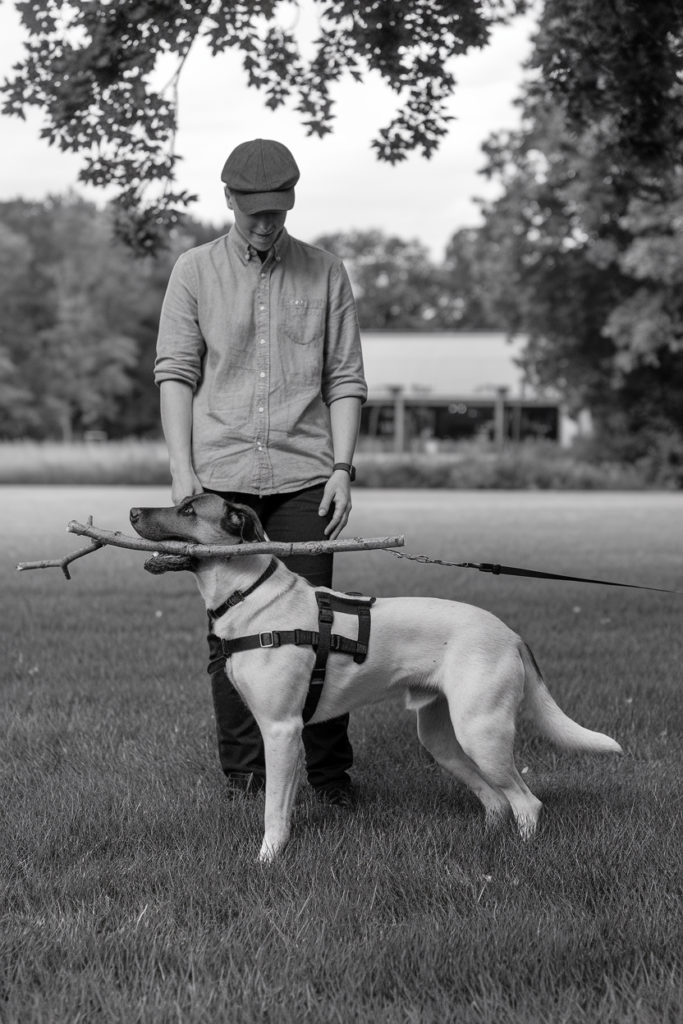
Training a service dog is a highly specialized process that requires time, dedication, and expertise. The goal is to prepare the dog to perform tasks that mitigate their handler’s disability, while also ensuring the dog behaves appropriately in public settings. This section will delve into the steps involved in training service dogs, the time commitment required, and what potential handlers should consider when preparing their dog for service work.
The Early Stages: Socialization and Basic Obedience
Training begins at a young age, often when the dog is just a few weeks old. During this stage, puppies are exposed to a variety of environments, people, and other animals to ensure they become well-socialized and confident in different settings.
- Socialization: Puppies are introduced to different sounds, textures, and experiences to reduce the risk of fear or anxiety later in life. This may include walks in busy areas, rides in vehicles, and interactions with people of all ages.
- Basic Obedience: Commands such as “sit,” “stay,” “come,” and “heel” are taught early on. These foundational commands are essential for the dog’s ability to function in public and perform tasks reliably.
Tip: Positive reinforcement is key during the early stages of training. Rewarding desired behaviors with treats, praise, and play helps reinforce learning and builds a strong bond between the dog and handler.
Fact: Socialization and basic obedience training can take up to 6 months, depending on the breed and the individual dog’s temperament.
Task-Specific Training
Once the dog has mastered basic obedience, they move on to task-specific training. This phase is tailored to the individual needs of the handler and focuses on teaching the dog the skills required to mitigate their disability.
- Guide Dogs: These dogs are trained to navigate obstacles, stop at curbs, and ignore distractions while leading their handler safely. They also learn “intelligent disobedience,” where they disobey commands that would put their handler in danger, such as walking into traffic.
- Medical Alert Dogs: These dogs are trained to detect changes in their handler’s body chemistry, such as the onset of a seizure or a drop in blood sugar levels. They learn to alert their handler through specific behaviors, such as pawing, barking, or nudging.
- Mobility Assistance Dogs: These dogs learn to provide physical support, retrieve items, and assist with tasks like opening doors and turning on lights. They are also trained to brace themselves to help their handler maintain balance.
Training Insight: Task-specific training can take several months to a year, depending on the complexity of the tasks and the dog’s aptitude for learning.
Case Study: A Labrador Retriever named Max was trained as a medical alert dog for a child with Type 1 diabetes. Max learned to detect low blood sugar levels by sensing changes in the child’s breath and skin odor. He would then alert the parents by barking and nudging them, giving them time to administer insulin or glucose.
Public Access Training
In addition to performing tasks, service dogs must be able to accompany their handler in public places without causing disruptions. Public access training focuses on teaching the dog to remain calm, focused, and well-behaved in a variety of environments.
- Key Skills: Dogs are trained to ignore distractions, such as food, people, and other animals. They also learn to stay close to their handler, navigate crowds, and respond to commands promptly.
- Challenges: Public access training can be challenging, as it requires the dog to maintain focus and composure in potentially overwhelming situations. Consistent practice in different environments is crucial to the dog’s success.
Fact: Public access training often includes visits to shopping centers, restaurants, public transportation, and other busy areas to ensure the dog is comfortable and reliable in any setting.
Quote: “Public access training is where service dogs truly shine, demonstrating their ability to remain composed and focused in even the most distracting environments.”
Ongoing Training and Reinforcement
Training doesn’t end once the dog is placed with their handler. Ongoing training and reinforcement are essential to maintaining the dog’s skills and ensuring they continue to perform their tasks effectively.
- Consistency: Handlers must consistently practice the tasks and commands with their dog to keep their skills sharp. Regular training sessions help reinforce learned behaviors and prevent regression.
- Problem-Solving: If issues arise, such as the dog becoming distracted or forgetting a task, additional training may be needed. Handlers should work with professional trainers to address any challenges and ensure the dog remains reliable.
Health Consideration: Regular veterinary check-ups are important to ensure the dog is physically and mentally healthy. Health issues can affect the dog’s ability to perform their tasks, so it’s essential to address any concerns promptly.
Owner-Training vs. Professional Training
While many service dogs are trained by professional organizations, some handlers choose to train their dogs themselves, a process known as owner-training. Both methods have their pros and cons.
- Professional Training: Dogs trained by organizations often undergo rigorous, standardized programs that ensure they are well-prepared for their roles. However, this option can be expensive and may involve long waiting periods.
- Owner-Training: Handlers who train their own dogs can tailor the training to their specific needs and form a strong bond with their dog. However, owner-training requires a significant time commitment and may not be suitable for all disabilities or breeds.
Fact: In the United States, owner-trained service dogs have the same legal rights as professionally trained dogs, provided they meet the necessary standards for behavior and task performance.
Quote: “Whether trained by a professional or their owner, a service dog’s primary role is to provide independence and support to their handler. The path to that goal may differ, but the result is the same—a life changed for the better.”
Costs Associated with Service Dogs
Owning a service dog is a significant financial commitment that goes beyond the initial purchase or adoption fee. The cost of a service dog can vary greatly depending on factors such as the breed, the dog’s training, and ongoing care. This section will break down the various expenses associated with service dogs, providing a detailed overview of what potential handlers should budget for.
Initial Costs: Acquisition and Training
- Purchase or Adoption Fee:
- The cost of acquiring a service dog varies widely. A dog purchased from a breeder can cost anywhere from $1,000 to $5,000, depending on the breed and the breeder’s reputation. Adoption fees from shelters or rescue organizations are typically lower, ranging from $50 to $300.
- Fact: Certain breeds, like Labrador Retrievers and Golden Retrievers, which are commonly used as service dogs, tend to have higher purchase prices due to their popularity and training potential.
- Professional Training Programs:
- Professional service dog training programs are one of the most significant expenses. The cost for a fully trained service dog from a professional organization can range from $15,000 to $50,000. This price reflects the extensive training the dog undergoes to meet the specific needs of their handler.
- Case Study: A professional training organization that specializes in mobility assistance dogs charged $25,000 for a fully trained Golden Retriever. The training included task-specific skills, public access training, and follow-up support after placement with the handler.
- Owner-Training Costs:
- For those who choose to train their own service dog, the costs can still add up. While you may save on professional training fees, you will need to budget for:
- Training Classes: Group or private training sessions with a professional trainer can cost anywhere from $50 to $200 per session.
- Equipment: Specialized equipment, such as vests, harnesses, and leashes, can cost $100 to $500 depending on quality and customization.
- Time Investment: Owner-training requires a significant time commitment. Balancing this with other responsibilities may result in indirect costs, such as reduced work hours or hiring assistance.
- For those who choose to train their own service dog, the costs can still add up. While you may save on professional training fees, you will need to budget for:
Tip: Grants and financial aid are sometimes available through non-profit organizations to help offset the cost of acquiring and training a service dog.
Ongoing Costs: Care and Maintenance
Once you have your service dog, ongoing care and maintenance become regular expenses. These costs are essential to keep your service dog healthy, happy, and capable of performing their duties.
- Veterinary Care:
- Regular vet check-ups, vaccinations, and preventive care are necessary to ensure the dog’s health. Annual veterinary care can cost $500 to $1,000, depending on the dog’s health and any additional medical needs.
- Unexpected Medical Costs: Emergency veterinary care, surgeries, or treatments for chronic conditions can add significantly to annual expenses. Pet insurance can help mitigate these costs, with premiums ranging from $20 to $70 per month.
- Food and Nutrition:
- A high-quality diet is essential for maintaining the dog’s energy levels and overall health. Expect to spend $500 to $1,200 per year on premium dog food.
- Dietary Supplements: Some service dogs, especially those that perform physically demanding tasks, may benefit from supplements like joint support or omega-3 fatty acids. These can add $100 to $300 annually.
- Grooming:
- Regular grooming is important for a service dog’s appearance and health. Professional grooming services can cost $50 to $100 per session, with most dogs needing grooming every 4 to 8 weeks. Alternatively, grooming at home can reduce costs but requires an investment in grooming tools.
- Fact: Breeds like Poodles, which are hypoallergenic and often used as service dogs, require more frequent grooming to maintain their coat.
- Supplies:
- Basic Supplies: Items such as bedding, toys, and grooming tools are recurring expenses. Plan to spend $100 to $300 annually on these supplies.
- Replacement Equipment: As your service dog ages, you may need to replace their harness, vest, or other specialized gear. Budgeting $50 to $200 per year for replacement equipment is advisable.
- Insurance and Liability:
- While not mandatory, pet insurance is highly recommended to cover unexpected medical expenses. Liability insurance is also worth considering, as it protects you in case your service dog inadvertently causes injury or damage. Combined, these policies can cost $300 to $1,000 annually.
Fact: According to the American Pet Products Association (APPA), the average annual cost of owning a dog is approximately $1,300 to $1,800, but service dogs may incur additional expenses due to their specialized roles.
Additional Costs: Continued Training and Support
- Refresher Training:
- Even after initial training, service dogs may require periodic refresher training to maintain their skills. Refresher courses can cost $100 to $500 depending on the duration and complexity.
- Quote: “Consistent training is essential to ensure that service dogs continue to perform their tasks effectively and maintain their public access skills.”
- Support and Maintenance:
- Some professional organizations offer ongoing support services, including consultations, training adjustments, and health monitoring. These services can cost $500 to $2,000 annually but are invaluable in ensuring the long-term success of the service dog-handler partnership.
Cost-Saving Tips and Financial Assistance
While owning a service dog is a significant financial commitment, there are ways to manage and reduce costs:
- Grants and Scholarships:
- Many non-profit organizations offer financial assistance to help cover the cost of acquiring and training service dogs. Research available grants and scholarships, especially those targeted towards specific disabilities.
- Tax Deductions:
- In some countries, service dog expenses can be claimed as tax deductions, including veterinary care, training, and food. Consult with a tax professional to see if you qualify.
- Crowdfunding:
- Some individuals turn to crowdfunding platforms to raise money for service dog expenses. Sharing your story and explaining the impact of a service dog can help garner support from friends, family, and the wider community.
- Veterinary Discount Programs:
- Many veterinarians offer discount programs or payment plans for service dogs. Enrolling in a wellness plan can also help spread the cost of veterinary care over the year.
FAQs About Service Dogs
Here are some frequently asked questions about service dogs, providing clarity on common concerns and misconceptions:
What is a Service Dog?
A service dog is a trained animal that performs specific tasks to assist individuals with disabilities. These tasks are designed to mitigate the effects of the handler’s disability, allowing them to lead a more independent life. Service dogs are trained to perform tasks such as guiding individuals with visual impairments, alerting to medical conditions, or providing mobility assistance.
What is the Difference Between a Service Dog, Therapy Dog, and Emotional Support Animal?
- Service Dog: Trained to perform specific tasks for individuals with disabilities. They have access rights to public places, including businesses, restaurants, and transportation.
- Therapy Dog: Provides comfort and emotional support in settings like hospitals or nursing homes. They do not have public access rights.
- Emotional Support Animal (ESA): Offers emotional comfort but is not trained for specific tasks. ESAs do not have the same public access rights as service dogs but may have housing rights under certain conditions.
What Types of Disabilities Can a Service Dog Assist With?
Service dogs can assist with a wide range of disabilities, including but not limited to:
- Visual Impairments: Guide dogs help individuals with blindness or severe vision loss navigate their environment.
- Hearing Impairments: Hearing dogs alert their handlers to sounds such as doorbells, alarms, or crying babies.
- Medical Conditions: Medical alert dogs can detect changes in blood sugar levels, seizures, or other medical conditions.
- Mobility Issues: Mobility assistance dogs help individuals with physical disabilities by providing support for balance, retrieving items, or opening doors.
How Can I Get a Service Dog?
- Professional Training Organizations: Many organizations specialize in training service dogs and pairing them with handlers. The process typically involves an application, interviews, and waiting lists.
- Owner-Training: Some individuals choose to train their own service dogs. This requires a significant time commitment and knowledge of specialized training techniques.
- Adoption: Some shelters and rescue organizations offer dogs that can be trained as service animals. Ensure the dog has the temperament and health needed for service work.
How Long Does It Take to Train a Service Dog?
Training a service dog can take from several months to over a year, depending on the dog’s age, breed, and the complexity of the tasks they need to learn. Basic obedience training starts early, followed by task-specific and public access training.
What Are the Legal Rights of Service Dogs?
Under the Americans with Disabilities Act (ADA), service dogs have the right to accompany their handlers in all public places, including businesses, restaurants, and transportation. They are also protected under housing laws and can be accommodated in no-pet housing.
Can a Service Dog Be Any Breed?
Yes, service dogs can be any breed or mix of breeds. However, certain breeds are more commonly chosen due to their temperament, size, and trainability. Popular service dog breeds include Labrador Retrievers, Golden Retrievers, and German Shepherds.
Are Service Dogs Required to Wear a Vest or Identification?
While service dogs are not legally required to wear a vest or identification, it is highly recommended. A vest or harness with identifying information can help signal to the public that the dog is working and should not be disturbed. It also helps in avoiding confusion with pets.
How Can I Tell If a Dog Is a Legitimate Service Dog?
A legitimate service dog will be well-behaved, focused on their handler, and able to perform specific tasks related to the handler’s disability. It is important to respect their working status and not distract or interact with them while they are on duty.
Can Businesses Refuse Service to a Service Dog Team?
Under the ADA, businesses cannot refuse service to a person with a service dog unless the dog is out of control or not housebroken. Businesses are allowed to ask two questions:
- Is the dog a service animal required because of a disability?
- What work or task has the dog been trained to perform?
What Should I Do If My Service Dog Is Denied Access?
If you are denied access with your service dog, you can:
- Educate: Explain your rights under the ADA and provide documentation if needed.
- File a Complaint: Contact the business’s management or file a complaint with the Department of Justice or other relevant authorities.
- Seek Legal Advice: Consult with an attorney who specializes in disability rights for further assistance.
How Can I Prepare My Home for a Service Dog?
Preparing your home involves creating a safe and comfortable environment for your service dog. Consider the following:
- Designate a Sleeping Area: Provide a clean and comfortable space for your dog to rest.
- Ensure Safety: Remove any hazards or obstacles that could pose a risk to your dog.
- Stock Supplies: Keep essential supplies such as food, water, grooming tools, and medical records readily available.

